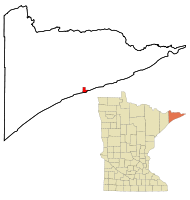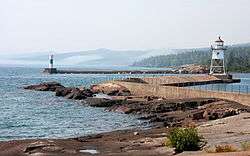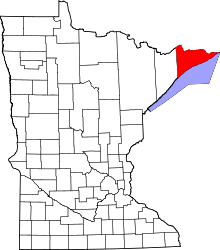Grand Marais, Minnesota
| Grand Marais, Minnesota | |
|---|---|
| City | |
|
Lake Superior harbor in downtown Grand Marais | |
 Location of the city of Grand Marais within Cook County, Minnesota | |
| Coordinates: 47°45′14″N 90°20′7″W / 47.75389°N 90.33528°WCoordinates: 47°45′14″N 90°20′7″W / 47.75389°N 90.33528°W | |
| Country | United States |
| State | Minnesota |
| County | Cook |
| Area[1] | |
| • Total | 2.90 sq mi (7.51 km2) |
| • Land | 2.90 sq mi (7.51 km2) |
| • Water | 0 sq mi (0 km2) |
| Elevation | 617 ft (188 m) |
| Population (2010)[2] | |
| • Total | 1,351 |
| • Estimate (2012[3]) | 1,344 |
| • Density | 465.9/sq mi (179.9/km2) |
| Time zone | Central (CST) (UTC-6) |
| • Summer (DST) | CDT (UTC-5) |
| ZIP code | 55604 |
| Area code(s) | 218 |
| FIPS code | 27-24992[4] |
| GNIS feature ID | 0656425[5] |
| Website | www.ci.grand-marais.mn.us |
Grand Marais is a city in Cook County, Minnesota, United States. The population was 1,351 at the 2010 census.[6] It is also the county seat and sole municipality of Cook County.[7] Grand Marais is French for "Great Marsh", referring to a marsh that, in early fur-trading times, was 20 acres (8.1 ha) or less in area, nearly at the level of Lake Superior, and situated at the head of the little bay and harbor that led to the settlement of the village there. Another small bay on the east, less protected from storms, is separated from the harbor by a slight projecting point and a short beach. The Ojibwe name for the area is Gichi-biitoobiig,[8] which means "great duplicate water," "parallel body of water" or "double body of water" (like a bayou), a reference to the two bays which form the large harbor off Lake Superior.[9]Located on the east side of Grand Marais is Chippewa City. Chippewa City thrived in the 1890s, with about 100 families living in the village. It was thought that this town would never dwindle. However, much of this community's room for housing was removed when Highway 61 was built through it. Grand Marais is a gateway to the Boundary Waters Canoe Area Wilderness. It is also a regional arts and crafts hub, as the home of nonprofit educational institutions, such as the Grand Marais Art Colony and the North House Folk School, and art galleries featuring the work of local and regional artists. Grand Marais is also the hometown of 300 Entertainment recording artist Cobi.[10]
Geography
According to the United States Census Bureau, the city has a total area of 2.90 square miles (7.51 km2), all of it land.[1] Grand Marais is located on the northwestern shore of Lake Superior in northeastern Minnesota. It is an entry point for the Boundary Waters Canoe Area Wilderness, situated at the beginning of the Gunflint Trail. The Superior Hiking Trail passes near Grand Marais, and Judge C. R. Magney State Park is nearby, with its unusual Devil's Kettle waterfalls.
The land surrounding Grand Marais slopes up to form the Sawtooth Bluff, a dramatic rock face visible from nearly any vantage point in the city. Adjacent to the bluff is Pincushion Mountain, a large bald monolith with dramatic views of Lake Superior and the inland wilderness.
Grand Marais Harbor is protected by Artist's Point, a barrier island formed by lava that was connected to the mainland by gravel deposited by lake currents, forming a tombolo. An Arctic–alpine disjunct community survives there.[11][12]
Road access to Grand Marais is by Minnesota Highway 61, which heads northeast, following the shore of Lake Superior, and is known as the North Shore Scenic Drive. The Gunflint Trail (Cook County Road 12) begins in Grand Marais and heads northwest, away from the lake and into the Boundary Waters region.
Grand Marais is located 110 miles northeast of Duluth and 40 miles southwest of the Canada–US border.
Climate
Grand Marais has a warm-summer humid continental climate (Köppen Dfb), like the rest of northern Minnesota. Because of the moderating influence of Lake Superior, summer temperatures are cooler, winter temperatures warmer, and the seasonal temperature difference is smaller than locations farther inland. With average highs of a little over 70 °F (21 °C) in July and August, Grand Marais has the coolest summer temperatures of any weather station in Minnesota. The difference between the temperature of the warmest and coldest months is only 47.6 °F (26.4 °C), significantly smaller than 58.9 °F (32.7 °C), the seasonal temperature difference in Tower, Minnesota, about 90 miles (140 km) to the west.[13] Despite being significantly farther north, Grand Marais lies in USDA hardiness zone 4b like Duluth and Minneapolis,[14] with an average yearly minimum temperature of −23 °F (−31 °C).[15]
| Climate data for Grand Marais, Minnesota (1981–2010 normals, extremes 1897-present) | |||||||||||||
|---|---|---|---|---|---|---|---|---|---|---|---|---|---|
| Month | Jan | Feb | Mar | Apr | May | Jun | Jul | Aug | Sep | Oct | Nov | Dec | Year |
| Record high °F (°C) | 52 (11) |
58 (14) |
67 (19) |
83 (28) |
88 (31) |
93 (34) |
99 (37) |
100 (38) |
90 (32) |
77 (25) |
67 (19) |
55 (13) |
100 (38) |
| Average high °F (°C) | 24.7 (−4.1) |
28.4 (−2) |
36.3 (2.4) |
47.4 (8.6) |
56 (13) |
63.6 (17.6) |
71.2 (21.8) |
72.1 (22.3) |
64.3 (17.9) |
52.1 (11.2) |
39.3 (4.1) |
28 (−2) |
48.7 (9.3) |
| Daily mean °F (°C) | 15.6 (−9.1) |
19.1 (−7.2) |
27.7 (−2.4) |
38.8 (3.8) |
47.0 (8.3) |
53.8 (12.1) |
61.5 (16.4) |
63.2 (17.3) |
55.8 (13.2) |
44.2 (6.8) |
32.3 (0.2) |
20.0 (−6.7) |
40.0 (4.4) |
| Average low °F (°C) | 6.5 (−14.2) |
9.9 (−12.3) |
19 (−7) |
30.1 (−1.1) |
37.9 (3.3) |
44 (7) |
51.7 (10.9) |
54.3 (12.4) |
47.4 (8.6) |
36.4 (2.4) |
25.2 (−3.8) |
12 (−11) |
31.3 (−0.4) |
| Record low °F (°C) | −34 (−37) |
−34 (−37) |
−24 (−31) |
−8 (−22) |
17 (−8) |
25 (−4) |
28 (−2) |
33 (1) |
23 (−5) |
6 (−14) |
−14 (−26) |
−27 (−33) |
−34 (−37) |
| Average precipitation inches (mm) | 0.81 (20.6) |
0.5 (13) |
0.87 (22.1) |
1.67 (42.4) |
2.53 (64.3) |
3.61 (91.7) |
3.12 (79.2) |
2.71 (68.8) |
3 (80) |
3.1 (79) |
1.7 (43) |
0.98 (24.9) |
24.6 (625) |
| Average snowfall inches (cm) | 14.2 (36.1) |
6.2 (15.7) |
6.4 (16.3) |
1.8 (4.6) |
0 (0) |
0 (0) |
0 (0) |
0 (0) |
0 (0) |
0.1 (0.3) |
3.1 (7.9) |
13.2 (33.5) |
45.7 (116.1) |
| Source: NOAA[16][17][18] | |||||||||||||
Demographics
| Historical population | |||
|---|---|---|---|
| Census | Pop. | %± | |
| 1910 | 355 | — | |
| 1920 | 443 | 24.8% | |
| 1930 | 618 | 39.5% | |
| 1940 | 855 | 38.3% | |
| 1950 | 1,078 | 26.1% | |
| 1960 | 1,301 | 20.7% | |
| 1970 | 1,301 | 0.0% | |
| 1980 | 1,289 | −0.9% | |
| 1990 | 1,171 | −9.2% | |
| 2000 | 1,353 | 15.5% | |
| 2010 | 1,351 | −0.1% | |
| Est. 2015 | 1,327 | [19] | −1.8% |
| U.S. Decennial Census | |||
2010 census
As of the census[2] of 2010, there were 1,351 people, 673 households, and 331 families residing in the city. The population density was 465.9 inhabitants per square mile (179.9/km2). There were 863 housing units, with an average density of 297.6 per square mile (114.9/km2). The racial makeup of the city was 93.4% white, 0.4% African American, 2.4% Native American, 0.5% Asian, 0.1% Pacific Islander, 0.6% from other races, and 2.5% from two or more races. Hispanic and Latino residents of any race were 1.6% of the population.
There were 673 households, of which 21.5% had children under the age of 18 living with them, 37.1% were married couples living together, 9.4% had a female householder with no husband present, 2.7% had a male householder with no wife present, and 50.8% were non-families; 43.7% of all households were made up of individuals and 18.6% had someone living alone who was 65 years of age or older. The average household size was 1.94 persons, and the average family size was 2.67.
The median age in the city was 48.4 years; 18.1% of residents were under the age of 18; 5.1% were between the ages of 18 and 24; 23.2% were from 25 to 44; 30.8% were from 45 to 64; and 23% were 65 years of age or older. The gender makeup of the city was 45.9% male and 54.1% female.
2000 census
As of the census[4] of 2000, there were 1,353 people, 645 households, and 341 families residing in the city. The population density was 506.7 people per square mile (195.7/km²). There were 722 housing units, with an average density of 270.4 per square mile (104.4/km²). The racial makeup of the city was 94.97% white, 2.81% Native American, 0.15% Asian, 0.15% Pacific Islander, 0.07% from other races, and 1.85% from two or more races. Hispanic and Latino residents of any race were 0.74% of the population. According to the census, 23.3% were of Norwegian, 20.2% German, 11.8% Swedish, 7.0% Irish and 6.1% English ancestry.
There were 645 households, of which 23.3% had children under the age of 18 living with them, 42.9% were married couples living together, 8.1% had a female householder with no husband present, and 47.1% were non-families; 42.0% of all households were made up of individuals, and 21.6% had someone living alone who was 65 years of age or older. The average household size was 2.01 and the average family size was 2.73.
In the city 18.8% of the population were under the age of 18; 6.1% were from 18 to 24; 25.9% were from 25 to 44; 22.8% were from 45 to 64; and 26.3% were 65 years of age or older. The median age was 45 years. For every 100 females there were 83.1 males. For every 100 females age 18 and over, there were 80.8 males.
The median income for a household in the city was $33,493, and the median income for a family was $46,563. Males had a median income of $31,500. The median income for females was $23,393. The per capita income for the city was $21,863. About 7.4% of families and 10.0% of the population were below the poverty line, including 11.9% of those under age 18 and 12.0% of those age 65 or over.
Festivals
Grand Marais is host to numerous festivals throughout the year. These festivals celebrate the unique history and culture of the North Shore and of the city itself.
- The Dragon Boat Festival is held during the last weekend in July. Each boat is shaped like a dragon, with 20 oarsman, a drummer, and a steersperson. The proceeds raised go to three North Shore nonprofit organizations: WTIP Radio, the North Shore Health Care Foundation and the North House Folk School.[20]
- Fisherman's Picnic is held in Grand Marais during the first weekend in August.[21] It originated in the days when the area's economy was based on logging and commercial fishing, and the community would gather for a shoreline potluck picnic featuring a fish fry of fresh Lake Superior herring. The tradition continues with the Lions Club's Famous Fishburger Stand. Herring, still provided by local commercial fisherman, is dipped in coating, fried golden brown and served piping hot on a hot dog bun.[22]
Historic lodges and resorts
- Naniboujou Lodge
- Lutsen Resort on Lake Superior
Media
Newspapers
- Cook County News-Herald
- Northern Wilds
Radio
- WMLS FM 88.7, Minnesota Public Radio classical
- WLSN FM 89.7, Minnesota Publc Radio news and talk
- WTIP FM 90.7, North Shore Community Radio
- WXXZ FM 95.3, rebroadcast of KQDS-FM in Duluth
Outdoor recreation
- Boundary Waters Canoe Area
- Isle Royale National Park
- Superior Hiking Trail Association
- Cascade River State Park
- Eagle Mountain
- Judge C. R. Magney State Park
- Border Route Trail
- Gunflint Trail
- Kekekabic Hiking Trail
- Pincushion Mountain Cross Country Ski Trail
- Grand Marais Recreation Area
- Devil's Kettle
- Lutsen Mountains
Culture
- Grand Marais Art Colony
- Grand Marais Playhouse
- North Shore Music Association
- Grand Portage National Monument
See also
References
- 1 2 "US Gazetteer files 2010". United States Census Bureau. Retrieved 2012-11-13.
- 1 2 "American FactFinder". United States Census Bureau. Retrieved 2012-11-13.
- ↑ "Population Estimates". United States Census Bureau. Retrieved 2013-05-28.
- 1 2 "American FactFinder". United States Census Bureau. Retrieved 2008-01-31.
- ↑ "US Board on Geographic Names". United States Geological Survey. 2007-10-25. Retrieved 2008-01-31.
- ↑ "2010 Census Redistricting Data (Public Law 94-171) Summary File". American FactFinder. U.S. Census Bureau, 2010 Census. Retrieved 23 April 2011.
- ↑ "Find a County". National Association of Counties. Retrieved 2011-06-07.
- ↑ Weshki-ayaad, Lippert, Gambil. Freelang Ojibwe Dictionary
- ↑ Warren Upham (1920). Minnesota Geographic Names: Their Origin and Historic Significance. Minnesota Historical Society. p. 136.
- ↑ http://wtip.org/content/west-end-news-october-11
- ↑ "Planning Framework: North Shore Scenic Drive: All-American Road" (PDF). Center for Changing Landscapes. University of Minnesota.
- ↑ "Appendix: North Shore Scenic Drive: All-American Road" (PDF). Center for Changing Landscapes. University of Minnesota.
- ↑ "Temperature Summary for Station USC00218311 - TOWER 2S, MN". Midwest Regional Climate Center. Retrieved 14 August 2016.
- ↑ "USDA Plant Hardiness Zone Map". Agricultural Research Service, U.S. Department of Agriculture. 2012. Retrieved 14 August 2016.
- ↑ "GRAND MARAIS, MINNESOTA (213282): Monthly Minimum of Minimum Daily Temperature (Degrees Fahrenheit)". Western Regional Climate Center. Retrieved 14 August 2016.
- ↑ "GRAND MARAIS, MINNESOTA (213282): 1981-2010 Monthly Climate Summary". Western Regional Climate Center. Retrieved 14 August 2016.
- ↑ "Temperature Summary for Station USC00213282 - GRAND MARAIS, MN". Midwest Regional Climate Center. Retrieved 14 August 2016.
- ↑ "Grand Marais mean of monthly snowfall sums 1981-2010". NOWData. National Weather Service Forecast Office, Duluth, MN.
- ↑ "Annual Estimates of the Resident Population for Incorporated Places: April 1, 2010 to July 1, 2015". Retrieved July 2, 2016.
- ↑ Accessed 06/27/11. "North Shore Dragon Boat Festival"
- ↑ Accessed 06/27/11."Grand Marais Fisherman's Picnic August 4–7, 2011"
- ↑ http://www.eastbaysuites.com/activities-and-events/events/fishermans-picnic.php East Bay Suites Website
External links
| Wikimedia Commons has media related to Grand Marais, Minnesota. |
-
 Grand Marais travel guide from Wikivoyage
Grand Marais travel guide from Wikivoyage - City of Grand Marais
- Grand Marais Chamber of Commerce
- Grand Marais Area Tourism Association

